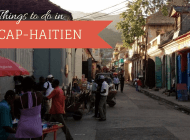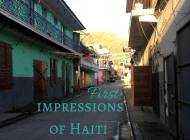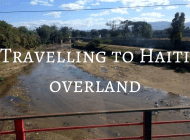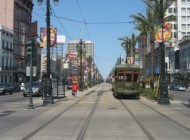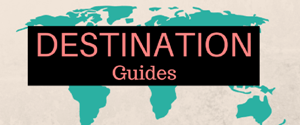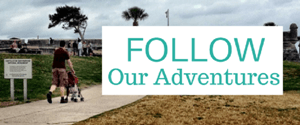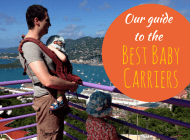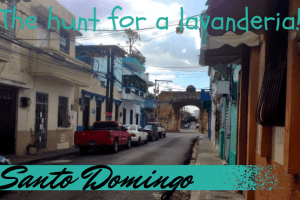There are two big attractions in this part of the world – the UNESCO listed Citadel and Sans Souci Palace. I was determined to see both on my Haiti side trip to Cap-Haitien, even though I had spent the night before quite ill.
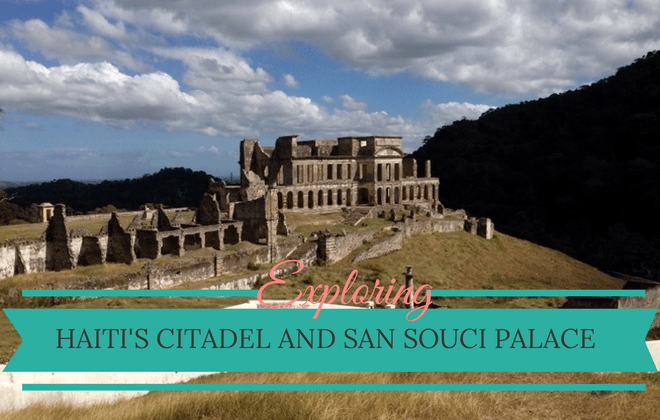
Contents
Getting to the Citadel
To get to the Citadel, I had to first get to Milot. I headed out at 7:30am and the streets were just starting to see some activity.
I followed the directions in the guide book as to where I could find a tap tap (local transportation) to Milot. According to Lonely Planet, it was meant to be on Rue 2, just over a bridge. There was no bridge where the map indicated, and instead, with some help, we found the tap taps originating on the bridge leading to Route Nationale #3, at the bottom of Rue A, which was the only bridge that seems to cross the Mapou River.
Once there a Tap Tap to Milot was easy to find; the fare collector shouted out the destination before the driver decided we were full enough to head off. That tap tap very quickly became very full as we headed to Milot, and I was crammed up against its massive sub woofer. The whole journey was – for me anyway- uncomfortable, although the roads were mostly in good condition most of the way and it was only half an hour.
With a lack of small change I handed over a 100 goude note and got 80 back in change, the tap tap fare collectors seem a lot more honest than their Dominican guagua counterparts. I was asked if I wanted to go to the Citadel and the tap tap dropped me off as close it could, right at the bottom of town. If you’re unsure, look for the large Catholic Church; the entrance is nearby.
Buying a ticket for the Citadel and getting a guide
Normally I wouldn’t get a guide to a place like this, because I am tight and I like to read up on a place myself. However, I hadn’t found any great sources of information online, and I was feeling sick and I didn’t feel like dealing with people so I decided to get a guide. As we pulled into Milot, a man saw me in the tap tap and jumped aboard. He went straight for me and it seemed that a guide had found me rather than the other way around.
He led me through the streets to the ticket office. He wouldn’t answer my questions as to cost, saying only it would be explained at the ticket office, but his assistance to that point was free.
At the ticket office, the cost for each service were listed. Admission was just $5 US per person, a guide was $20 for one or two people, and then increasing up to $50 US for a part of 10; $25 in total for me. I decided to go with the guide. I asked to pay in goudes and was charged 1300. This fee covers both the Citadel and the Sans Souci palace, which we could do in whatever order I wanted to.
My guide explained later that he didn’t receive all of the fee, but that most of it went to the guide association, representing 43 guides that were allowed to show people the site. All money collected was then divided up between the guides. I don’t know if this was his way of lobbying for a tip, but when I offered him one later he looked puzzled (maybe my tip was just crap).
Climbing up the mountain to the Citadel
I decided to explore the Citadel first. However, the Citadel is on the summit of the Bonnet a L’Eveque mountain, 910 metres high. The trail to the top is roughly 11km long, switching back and forth across the steep mountain. It is walkable if you’re keen but road is rough. I was not feeling up to it.
There are two other options: motorcycle and horse. Each one costs $15 US but have their own pros and cons. A motorcycle is quicker, and can carry two people (so a guide can share with you), but the journey is much rougher. A horse is slower and if you get a guide then they would need their own horse (at another $15). However, horses can go all the way to the top, whereas the last ~3km of the track is closed to vehicular traffic. I believe either will wait to take you back down the mountain. With time and money an issue I opted for the motorcycle. Again I asked to pay in goudes and was charged 700, when it should have been closer to 650.
The motorcycle was a rough ride, and I was sandwiched in between the driver and my guide. The bike broke down, but the guide proved his worth by ordering someone out of a chair so I could sit (he said it was his niece), getting everyone else to leave me alone, and heading back down to the bottom to get the bike fixed. Eventually a replacement came and took us to the car park area.
Recently done up, the car park marks the limit motorised transport is allowed to go. I had to show my ticket at an office, and also vouch that I had paid for my guide and he wasn’t just hassling me. The facilities at the parking area are quite good, there’s a small kiosk/restaurant, lots of shade and places to sit, and good clean toilets. You can hire horses to complete the last part of the journey, but I decided to go on foot. The bike had carried us most of the way, so how hard could it be?
It was tough; very tough in my position. The closer we got to the top the steeper it got. My guide offered me a shortcut, but said it would be rough. I passed. Luckily, although sunny, there was a gentle breeze so the heat was tolerable, but the increasingly steep road forced me to stop several times. Between my illness and my lack of fitness I needed to compose myself to refrain from vomiting and catch my breath. It probably would have taken 30 minutes without all the stops but it took us 45 minutes to reach the top. It wasn’t a walk for kids.
The Citadel
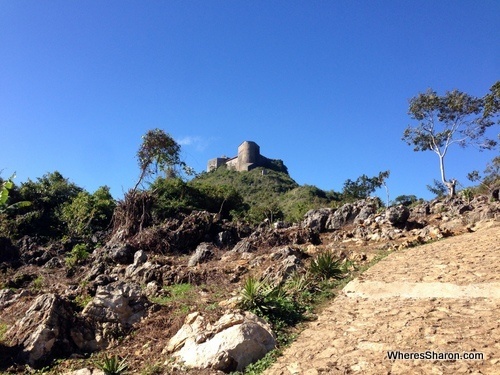
First glimpse of the Citadel
The climb was well worth it, for the Citadel is an impressive feat of engineering. As I approached the Citadel, the front looked like the bow of a ship sticking off the top of the mountain. Even setting aside its location, the fortress is massive.
Work on Citadelle Laferrière commenced in 1805 and 20,000 workers laboured on it for 15 years. It was designed as part of a series of fortifications to guard against a French invasion of Haiti, and when Haiti split into North and South it became the redoubt of the King of North Haiti, Henry Christopher. The Citadel added palace quarters for the King and his family, as well as supplies and water cisterns for them and a garrison of 5000 for a year. Such was the fear of a French invasion the architects and engineers responsible for the design were killed to prevent any details falling into French hands.
Construction stopped when King Henry committed suicide and his house was overthrown. At the time there were 360 captured European cannons in the Citadel, and it is still home to more than 150 – supposedly the largest collection of 18th century cannon in the world. The fortress was never attacked. It was designated a UNESCO world heritage site in 1982.
Exploring the Citadel
We started by walking to the rear entrance. My guide pointed out the different defensive aspects to the fortress of which there are many. At the rear is a parade ground where a massive 50,000+ cannon balls sit piled up, waiting for an attack that never came.
We were soon inside the Citadel, climbing stair after stair. I was half tempted to give up again, but if there was one thing my guide was good for it was enthusiasm. He urged me on and constantly checked I was okay, having figured out I wasn’t too good.
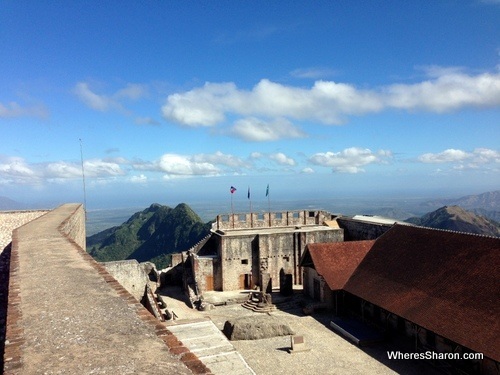
Exploring the Citadel
We started with looking at some of the cannons, still mounted on their wooden firing mounts, pointing out of their gun ports. Looking out of the ports, to the rear, we could see a small collection of four smaller forts, guarding the rear approach. These were located along the crest of the mountain which was considered the only way to approach the Citadel. My guide called them the Queen’s palace and said this is where the queen and any family were sent when the King visited the Citadel.
We explored various rooms, and I saw a mural depicting the life of Henry Christopher, painted after he died. There was a lot of construction work going on in places; a hotel is being built within the walls of the Citadel itself.

One of the original doors of the Citadel, now on display at the Cannon gallery.
Next came climbing onto the roof of one of the buildings. Not all stairs were safe, so some areas were off limits. However the views from the top of the main keep were astonishing. I could see Cap-Haitien off in the distance, as well as it’s airport, and far out to sea. On one of the lower levels was the whitewashed tomb of King Henry, who was interred here by loyal followers after his suicide.
In the main courtyard there is a souvenir shop, and my guide had it opened up for me to have a look. Sadly I was only after a postcard, and it had none at that time so I left empty handed. Drinks and some snacks are available.
We headed down to the famous cannon gallery, which contained a row of cannons defending the main approaches to the Citadel. Inspecting the cannons it is possible to see the 18th century insignia of European monarchs and nations who had built them in the first place. English, Spanish and French cannons were most numerous. Finally, we went through the front of the Citadel, with my guide pointing out interesting things like the dungeon.
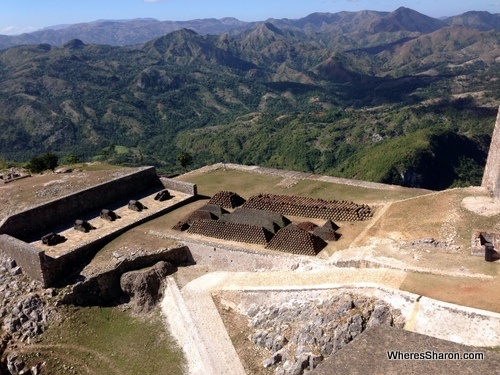
Views from the Citadel
He didn’t know much more than what I had read before, my guide, but he was good at pointing out cool things like that, and taking photos, and for being enthusiastic and keeping me going.
It was time to head back down. We’d spent 45 minutes wandering around and seen all the main sights. As we walked down he again offered the short-cut. This time I took it, but it was very steep and a little dangerous (it would be safer going up) and I regretted taking it. It did save some time though, for we were soon back at the car park where our motorcycle was waiting. We barely needed the engine, rolling down hill like on a push bike most of the way.
The Sans Souci Palace
We were dropped off at the top of the area for the Sans Souci palace. We went through a hole in the fence and on the way my guide described what the palace would have been like in it’s prime.

What remains of Sans Souci, looking down from the road to the Citadel.
The Sans Souci Palace was the normal residence of King Henry and designed to make a statement about his civility and cultural prowess. There were gardens, a large pool, many support buildings and houses for staff, a water works supplying running water and even a hospital. The palace was started in 1810 and finished in 1813, and was considered one of the best buildings in the Caribbean. Its name means carefree.
After an earthquake in 1842, the palace was badly damaged and abandoned, and today, only some of the walls of the palace remain, along with the foundations of some of the other buildings. The hospital appears to have survived and is now a primary school. All that is left of the gardens is an impressive banyan tree.
There wasn’t much to see. My guide showed me what was known about the palace, like where the toilets and the kitchen were. He explained where the king’s bedroom was (on the third level, but none of the stairs have survived), and took me to the front, where he explained how the palace was black and yellow and that there were two bronze lions at the front entrance before they were taken. But that was it, maybe 15 minutes top, and that was drawing it out. Interesting, but not amazing.

The ruins of Sans Souci palace.
I handed my guide a small tip, and he looked at me puzzled before taking it then summoning the motorcycle rider who had gone round to the front of the palace. He told the rider to take me to where the tap taps departed, and bade me farewell.
My verdict?
All in all I am very glad that I went to the effort of seeing the Citadel. The palace alone wouldn’t have been worth the effort but the Citadel is truly stunning, like nothing else I’ve seen. Although more like a medieval castle than a fort you’d see elsewhere for that time period, it’s hard to believe that it could have been taken at all, until modern 20th century artillery was created. It’s hard to get to, the walls are 40 metres tall and 4 metres thick. The location is stunning and makes the effort worth it.
Hiring a guide was, although pricey, a good use of money, if only for all the help he provided in arranging things and keeping everyone else from bothering me. A motorcycle certainly helped as the ascent is not easy, but with water (you can buy it along the route if needed) and two hours it is walkable – even in the tropical heat. And finally, in retrospect I’d have started with the Sans Souci Palace first – because after the Citadel it was a bit of an anti-climax.
You can also read about my journey to Haiti overland from the Dominican Republic, my first impressions of Haiti and the other things there are to do in Cap-Haitien.
Tags: Haiti Travel Blog





